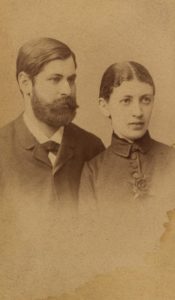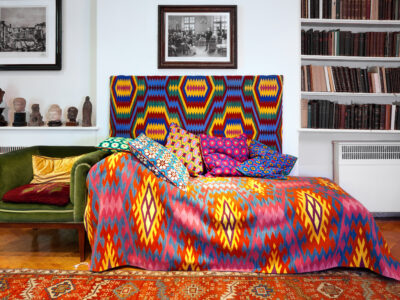Freud wore this ring for 53 years, engraved with his wife Martha’s name and the date of their marriage, 13th September 1886.

Sigmund Freud’s wedding ring
Martha Bernays was a 20-year-old friend of Freud’s sisters when he first met her at his home in April 1882. Within a short time he was passionately in love and his feelings were reciprocated. However, Martha’s widowed mother was not keen for Martha to marry this penniless doctor in training and moved the Bernays family to Wandsbek, near Hamburg, Germany.
Freud continued his medical schooling in Vienna and Paris, writing constantly to his new love. Martha wrote back and the hundreds of letters form a biography of the two young lovers’ lives through the early 1880s.
The couple would inform each other of their daily activities and surroundings while apart, with Freud sketching diagrams of his student lodgings in letters to Martha, as well as making bold proclamations of love and plans for their shared future (letter to Martha Bernays, 5.10.1883).

Sigmund and Martha Freud’s wedding portrait
Sigmund Freud and Martha Bernays’ courtship lasted four years.
When he proposed marriage, Freud was living in Vienna and Martha with her family in Hamburg. Freud took this ring with him to Hamburg in a matchbox. He had inscribed the matchbox lid with a poem from a famous anthology of German folk poems Des Knaban Wunderhorn (‘The Youth’s Magic Horn’). The poem, entitled ‘When my Sweetheart is Married’, is about a travelling journeyman’s grief at losing his love to another. Fortunately for Freud this didn’t happen and Martha accepted his proposal.
Freud’s letter writing continued and every time he travelled without Martha he would send postcards and letters home. Occasionally these notes would include news about a new antiquity, allowing us an all-too-briefly glimpsed clue as to when and where he acquired his extraordinary collection.
The couple raised a family of six children in Vienna, escaping Nazi-occupied Austria for London in 1938. Their wedding portrait, menu and even a personalised napkin ring from the day was kept and is now on display in the Freud Museum London.




Comments
I’m a retired clinical psychologist and loved my chosen profession!
Freud decided clitoral orgasms were an “immature” expression of sexuality. However, Marriage was his input on this whole hysteria phenomenon, and he believed that the cause was the woman’s loss of her metaphoric penis, only to be cured by marrying a man and fulfilling her loss. How did he never compare his ‘metaphoric’ penis orgasm to hers, or the lack of it? Was her release of excess fluid during orgasm a threat?
I wonder how his wife appreciated his decision. The only comparison to a clitoral orgasm is a penile orgasm. Did he consider his orgasms to be as immature as women, and did his wife ever have a clitoral orgasm or an orgasm of any kind? Did she experiment with masturbation alone or with a physician without his knowledge, as many women of that time did?
What were men afraid of/for by women having an orgasm? Many seem to enjoy their orgasms much more than men. Was it they didn’t want to share ‘their’ orgasm to be superior, which men did and still do for some reason?